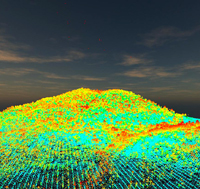
The European Parliament promoted action on climate change mitigation by inviting experts from across Europe to discuss the challenges and opportunities of sustainable forest management with Members of the European Parliament.
 |
| Lidar image: LIFE FOREST CO2 |
The meeting was hosted by representatives from the Spanish region of Murcia, which is carrying out a LIFE project on techniques that could help forests mitigate climate change.
The main challenge addressed by the LIFE FOREST CO2 project is to formulate a common methodology to keep track of greenhouse gas emissions and removals in Europe's farms and forests.
At present, there is no internationally recognised procedure to chart the carbon flowing in and out of land use, land use change and forestry (LULUCF). The project expects to standardise accounting techniques in line with EU objectives on climate action.
Vice-president of the European Parliament Ramón Luis Valcárcel opened the meeting by saying that projects such as LIFE FOREST CO2, which demonstrate the benefits of using resources sustainably, are the "reason for LIFE to continue and be strengthened in the next funding programme".
His remarks were followed by presentations on the aims and issues addressed by the project. Consuelo Rosauro Meseguer, Natural Habitat General Director from the Region of Murcia, emphasised that forest owners are already signing agreements to manage their land in a sustainable way. An ecological label for wood-based products has been instrumental in encouraging the forestry sector to participate in the project.
Ms Rosauro Meseguer described Murcia as a "delicate" region for its small forestry sector. The recently introduced LULUCF Regulation aims to ensure that natural areas, which currently remove on average 10% more CO2 from the atmosphere than they emit, remain carbon sinks, or at least carbon neutral in the future. This presents a challenge in her area given the diminishing capacity of its ageing forests to lock in more carbon and increasing competition for land.
"LIFE FOREST CO2 is working with landowners and businesses to create confidence in a voluntary market of carbon credits," explained project leader Miguel Chamón Fernández. "The way to ensure trust and thus greater participation among forest owners and industry is through better methodology."
The accounting procedures that the project is drawing up will help keep track of CO2 emissions and carbon sequestration in forests. Once tested in Murcia, the technique will be replicated in France in view of a broader European roll-out.
Source: © European Union, 1995-2017

